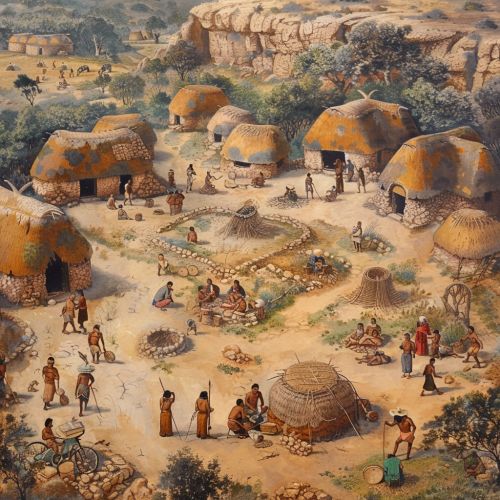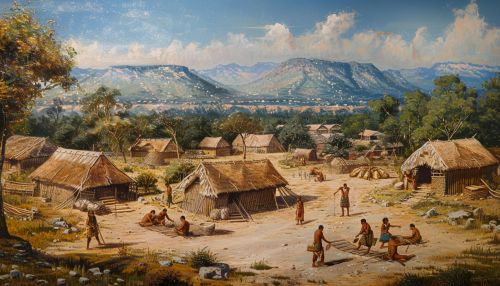History of Los Angeles: Difference between revisions
(Created page with "== Early History == The history of Los Angeles, California, begins with the indigenous peoples who inhabited the region for thousands of years before European contact. The area was originally home to the Tongva (or Gabrieleño) and Chumash tribes. These Native American groups developed complex societies with sophisticated trade networks, spiritual practices, and agricultural systems. <div class='only_on_desktop image-preview'><div class='image-preview-loader'></div></d...") |
No edit summary |
||
| Line 3: | Line 3: | ||
The history of Los Angeles, California, begins with the indigenous peoples who inhabited the region for thousands of years before European contact. The area was originally home to the Tongva (or Gabrieleño) and Chumash tribes. These Native American groups developed complex societies with sophisticated trade networks, spiritual practices, and agricultural systems. | The history of Los Angeles, California, begins with the indigenous peoples who inhabited the region for thousands of years before European contact. The area was originally home to the Tongva (or Gabrieleño) and Chumash tribes. These Native American groups developed complex societies with sophisticated trade networks, spiritual practices, and agricultural systems. | ||
[[Image:Detail-92127.jpg|thumb|center|Depiction of Tongva village with traditional dwellings and people engaged in daily activities.|class=only_on_mobile]] | |||
[[Image:Detail-92128.jpg|thumb|center|Depiction of Tongva village with traditional dwellings and people engaged in daily activities.|class=only_on_desktop]] | |||
=== Spanish and Mexican Periods === | === Spanish and Mexican Periods === | ||
Latest revision as of 02:01, 18 June 2024
Early History
The history of Los Angeles, California, begins with the indigenous peoples who inhabited the region for thousands of years before European contact. The area was originally home to the Tongva (or Gabrieleño) and Chumash tribes. These Native American groups developed complex societies with sophisticated trade networks, spiritual practices, and agricultural systems.


Spanish and Mexican Periods
In 1542, the Portuguese explorer Juan Rodríguez Cabrillo claimed the area for Spain, but it wasn't until 1769 that the first European settlement was established by the Spanish. The settlement was part of the Spanish mission system, which aimed to convert the indigenous population to Christianity and integrate them into Spanish colonial society. The Mission San Gabriel Arcángel, founded in 1771, played a crucial role in the region's development.
In 1781, a group of 44 settlers known as "Los Pobladores" founded El Pueblo de Nuestra Señora la Reina de los Ángeles, which translates to "The Town of Our Lady the Queen of the Angels." This small agricultural community grew slowly under Spanish rule, and later under Mexican rule after Mexico gained independence from Spain in 1821.
American Era
The Mexican-American War (1846-1848) resulted in the Treaty of Guadalupe Hidalgo, which ceded California to the United States. Los Angeles was officially incorporated as a city on April 4, 1850. The discovery of gold in California in 1848 led to a massive influx of settlers and rapid economic growth.
During the late 19th century, Los Angeles experienced significant development. The arrival of the Southern Pacific Railroad in 1876 and the completion of the Los Angeles Aqueduct in 1913 were pivotal events that facilitated the city's expansion. The aqueduct, designed by William Mulholland, brought water from the Owens Valley, enabling the city to grow beyond its natural water supply limits.
20th Century Growth
Early 20th Century
The early 20th century saw Los Angeles transform into a major metropolitan area. The discovery of oil in the Los Angeles Basin in the 1890s spurred economic growth and attracted a diverse population. By the 1920s, Los Angeles had become a center for the entertainment industry, with Hollywood emerging as the film capital of the world.
The city's population continued to grow rapidly, reaching over one million by 1930. The development of the Port of Los Angeles and the expansion of the aerospace industry during World War II further solidified the city's economic base.
Post-War Era
The post-war era was marked by suburbanization and the construction of extensive freeway systems. The Federal-Aid Highway Act of 1956 facilitated the development of the Interstate Highway System, which played a crucial role in shaping the city's urban landscape. The construction of the Los Angeles International Airport (LAX) in 1930 and its subsequent expansions also contributed to the city's growth as a major transportation hub.
The 1960s and 1970s were periods of social and political change. The Civil Rights Movement, the Chicano Movement, and the Watts Riots of 1965 highlighted issues of racial inequality and social justice. These events had a profound impact on the city's socio-political landscape.
Modern Los Angeles
Economic and Cultural Development
In the late 20th and early 21st centuries, Los Angeles continued to evolve as a global city. The city's economy diversified, with significant contributions from the entertainment, technology, and international trade sectors. The Silicon Beach area emerged as a hub for tech startups and innovation.
Culturally, Los Angeles became known for its diverse population and vibrant arts scene. The city is home to numerous cultural institutions, including the Los Angeles County Museum of Art (LACMA), the Getty Center, and the Walt Disney Concert Hall. The annual Academy Awards, held in Hollywood, continue to be a major event in the entertainment industry.
Challenges and Resilience
Los Angeles has faced numerous challenges, including natural disasters such as earthquakes and wildfires. The 1994 Northridge earthquake caused significant damage and highlighted the city's vulnerability to seismic activity. Efforts to improve earthquake preparedness and building standards have been ongoing.
The city has also grappled with issues such as homelessness, traffic congestion, and environmental sustainability. Initiatives to address these challenges include the development of public transportation systems, affordable housing projects, and environmental conservation efforts.
